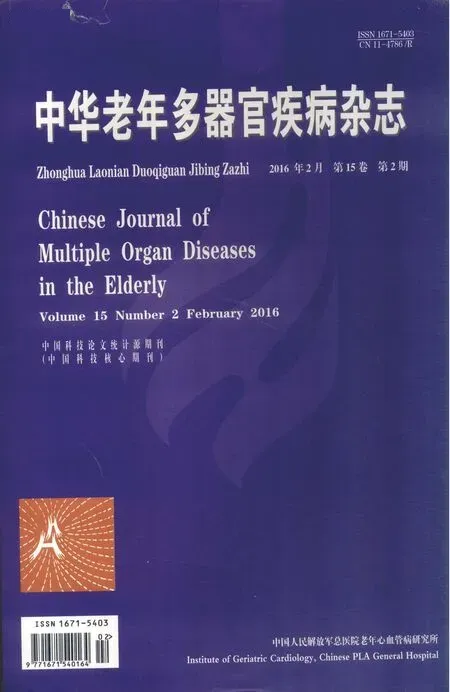高龄男性肌少症患者的活动能力与下肢肌肉质量和肌力的相关性研究
2016-04-21朱亚琼
朱亚琼,周 明,彭 楠
高龄男性肌少症患者的活动能力与下肢肌肉质量和肌力的相关性研究
朱亚琼,周 明,彭 楠*
(解放军总医院南楼康复医学科,北京 100853)
探讨高龄(>85岁)男性肌少症患者的活动能力与其下肢肌肉质量和下肢肌力的相关性。根据亚洲肌少症工作组(AWGS)纳入和排除标准,入选2014年6月至2015年2月于解放军总医院门诊部查体的87名高龄肌少症男性患者,年龄(89.5±4.4)岁,平均相对骨骼肌肉质量指数(RASMMI)为(6.04±0.62)kg/m²。分别对研究对象进行身体成分测试、握力测试、下肢肌力测试(分别测试髂腰肌、股四头肌、胫前肌及腘绳肌的最大等长肌力),并研究上述指标与活动能力测试如步速(6min最大步行速度测试)、计时“起立−行走”时间测试(TUGT)、5次起坐时间测试(FTSST)和闭目单腿站立测试的相关性。步速、TUGT、FTSST、闭目单腿站立时间主要与年龄(=−0.567,=0.018;=0.742,=0.001;=0.632,=0.007;=−0.489,=0.047)、下肢肌肉质量(=0.489,=0.045;=−0.579,=0.012;=−0.641,=0.003;=0.476,=0.048)和下肢脂肪含量(=−0.517,=0.032;=0.513,=0.031;=0.528,=0.015;=−0.533,=0.012)相关。步速、TUGT、FTSST、闭目单腿站立时间与髂腰肌肌力(=0.313,=0.000;=−0.887,=0.000;=−0.666,=0.003;=0.515,=0.035)和与股四头肌肌力(=0.251,=0.017;=−0.775,=0.000;=−0.612,=0.013;=0.671,=0.002)相关。高龄肌少症老人的活动能力与身体成分及下肢肌力相关程度较高。脂肪含量高而下肢肌肉质量低的老年人活动能力相对差;下肢肌力高的老年人活动能力较好,尤其以股四头肌、髂腰肌肌力为代表。
老年人;肌少症;肌肉质量;肌力
肌少症(sarcopenia)是国内外老年医学研究的热点,它是指随着年龄的增长,机体的四肢肌肉质量下降、脂肪组织增加,肌肉的爆发力、耐力下降及机体功能不同程度减低引起跌倒、残疾等不良事件发生的“老年综合征”[1]。研究发现我国>80岁老年人肌少症的发病率>50%[2]。肌少症对老年人的危害大,使老年人的跌倒风险、致残率和死亡率均增加[3]。肌力弱的高龄老人行走困难、易跌倒,活动受限,甚至日常起居亦受影响,生活质量严重降低。当前,较为缺乏>85岁的高龄老人的活动能力与其身体成分和下肢肌力的相关性分析资料及研究。因此,本研究希望在针对我国高龄肌少症患者提供恰当干预方式的研究方面提供一定的理论基础,并进一步了解增加肌肉质量与肌力对老年肌少症患者活动能力的影响。
1 对象与方法
1.1 研究对象
选择2014年6月至2015年2月于解放军总医院门诊部查体的老年男性肌少症患者87例,年龄(89.5±4.4)岁。纳入标准:(1)能够独立行走;(2)自愿参加本研究。排除标准:(1)近期疼痛、骨折、手术史;(2)简易智能量表(mini-mental state examination,MMSE)<27分;(3)言语、听力障碍;(4)深感觉障碍;(5)严重前庭功能障碍;(6)严重骨骼、肌肉系统疾病;(7)严重心脑血管系统疾病;(8)严重神经系统疾病;(9)疾病急性发作期等。男性肌少症的诊断根据亚洲肌少症工作组(Asian Working Group on Sarcopenia,AWGS)意见:年龄≥60岁的老年人步速<0.8m/s或握力下降<26kg,同时伴有相对骨骼肌肉质量指数(relative appendicular skeletal muscle mass index,RASMMI)下降<7.0kg/m2[4]。
1.2 测量工具和方法
身体成分测试采用双能X线(dual-energy X-ray absorptiometry,DXA)骨密度仪;握力测试采用握力计(JAMAR);下肢肌力测试采用美国进口便携手持式测力仪(FET3),分别测试髂腰肌、股四头肌、胫前肌及腘绳肌的最大等长肌力,测量范围0.37~90.82kg(精确度:±0.01kg)。
测试方法如下。(1)平均骨骼肌肉质量指数:DXA测试大腿肌肉质量、四肢肌肉质量、全身肌肉质量、全身脂肪含量、大腿骨矿盐含量、全身骨矿盐含量,并计算体脂百分比。(2)肌力测试:上肢握力测试;下肢肌力测试[5],包括屈髋肌(髂腰肌),伸膝肌(股四头肌),足背屈肌(胫前肌)和屈膝肌(腘绳肌)。(3)活动能力测试:6min最大步行速度测试;计时“起立−行走”时间测试(time up and go test,TUGT);5次起坐时间测试(five times sit-to-stand test,FTSST);闭目单腿站立时间测试。
测试流程:测试前1d通知受试者保持正常作息规律,避免剧烈运动。测试时光足、单衣。向受试者说明测试的目的和方法,并签署知情同意书。各项仪器校正完毕无误后,进行身体成分、上肢握力和下肢肌肉力量测试、活动能力的测试。
1.3 统计学处理

2 结 果
2.1 一般临床资料
研究对象均为高龄肌少症男性,其基本情况见表1。

表1 高龄男性肌少症患者基本情况表
BMI: body mass index; RASMMI: relative appendicular skeletal muscle mass index
2.2 身体成分测量
步速、TUGT、FTSST、闭目单腿站立时间主要与年龄、下肢肌肉质量和下肢脂肪含量相关(均<0.05;表2)。
2.3 下肢肌力测量
步速、TUGT、FTSST、闭目单腿站立时间与髂腰肌肌力和股四头肌肌力相关(均<0.05)。此外,TUGT还与胫前肌和腘绳肌相关(均<0.05;表3)。
3 讨 论
欧洲老年肌少症工作小组(European Working Group on Sarcopenia in Older People,EWGSOP)与AWGS在肌少症的诊断标准中都强调机体功能即活动能力的降低。老年人肌肉质量、肌力及活动能力均下降,严重降低生活质量,被视为老年肌少症患者的主要负面影响[6]。本研究阐述了身体成分(肌肉质量等)、下肢肌力与活动能力的关系。年龄越大、脂肪含量越高,老年人的活动能力越差;肌肉含量(尤其下肢)、大腿骨矿盐含量越高,老年人活动能力则越好。活动能力受多种混杂因素的影响,其中肥胖可能会增加促炎性细胞因子如IL-6、TNF-α、C反应蛋白等,导致肌肉脂肪化[7,8],使体内储备的肌肉质量不足以维持正常的活动。我们研究发现,步速与下肢脂肪含量、体脂百分比、下肢肌肉质量、全身肌肉质量、大腿骨矿盐含量相关(均<0.05)。有研究表明[9],患有少肌性肥胖的老年人比单纯患有肌少症或肥胖的人群,步速更慢,与我们研究结果一致。
另有研究显示[10],全身肌肉质量和四肢肌肉质量与肌少症患者5年内死亡率相关。TUGT、FTSST均与下肢肌肉质量、大腿骨矿盐含量呈负相关,与年龄、下肢脂肪含量呈正相关,说明下肢肌肉质量及骨矿盐量有助于起坐、行走等活动。1项meta分析提示,对于>65岁的老年人,BMI≥30和肌肉质量低与机体功能下降相关[11]。闭目单腿站立测试反映了机体的平衡能力,与下肢肌肉质量呈正相关,下肢肌肉质量高、脂肪含量低则平衡性好,可避免老年人在行走、登高时跌倒。其次,平衡能力还与年龄相关,Lord等[12]发现,随年龄增大,平衡能力下降,摔倒次数增多;King等[13]也发现平衡能力强弱的分水岭在60岁,≤60岁平衡能力恒定且较强,>60岁每10年下降≥16%。
步速、TUGT、FTSST、闭目单腿站立测试共同体现了老年人日常生活最为基本的活动技巧。测试过程中老年人需完成起立、向前直线行走、转身绕过障碍物、坐下等一系列功能活动。本研究显示,高龄老人活动能力与下肢肌力紧密相关,且活动能力与髂腰肌、股四头肌肌力相关性更高,这也证实了股四头肌神经肌肉兴奋性的破坏与活动能力下降相关联的说法[14−16]。TUGT还与Berg平衡量表、步速、Barthel指数呈中度至高度相关[17]。FTSST有较好的重测信度(ICC=0.91,95%CI:0.79~0.96),主要反映股四头肌群的快速激活能力,若激活能力强,则步行速度快[14];且FTSST与短期身体活动能力得分(short physical performance battery score,SPPB)成正相关[15,16]。因此,TUGT、FTSST均可作为老年人肌力及活动能力下降的预测指标。1项研究显示[16],对2 735名社区老年人进行测试,在去除性别、跌倒史、用药及独居因素后,发现FTSST是反复跌倒的独立风险因子(OR=1.74,95%CI:1.24~2.45,<0.001)。老年人下肢肌力降低、步态发生改变,动态平衡能力较差,因此增加了跌倒的风险。

表2 高龄肌少症男性活动能力与身体成分的相关性
TUGT: time up and go test; FTSST: five times sit-to-stand test

表3 高龄肌少症男性活动能力与下肢肌力的相关性
TUGT: time up and go test; FTSST: five times sit-to-stand test
本项研究存在一些不足之处。首先,样本量相对较小,不足以有效推测中国高龄人群的状况。其次,排除了过度虚弱及失能受试者,这可能对结果产生一定的影响。此外,目前对肌少症的诊断并无统一的标准,若分别应用AWGS、EWGSOP推崇的标准,得出的研究结果可能存在差异,因而我们在今后的工作中应进一步进行对比研究。
综上所述,高龄老人的活动能力与身体成分及下肢肌力相关性较高。脂肪含量高而肌肉质量低的老年人活动能力相对较差,而下肢肌力高的老年人活动能力好,尤其以股四头肌、髂腰肌肌力为代表。北京社区>80岁的老年人中,肌少症的发生率较高。以后的研究应当注重肌少症和少肌性肥胖对高龄老人产生的临床影响。
[1] Zhu YQ, Peng N, Zhou M. Pathogenesis of sarcopenia[J]. Chin J Mult Organ Dis Elderly, 2014, 13(8): 637−640. [朱亚琼, 彭 楠, 周 明. 肌少症的发病机制[J]. 中华老年多器官疾病杂志, 2014, 13(8): 637−640.]
[2] Rolland Y, Czerwinski S, Van Kan GA,. Sarcopenia: its assessment, etiology, pathogenesis, consequences and future perspectives[J]. J Nutr Health Aging, 2008, 12(7): 433−450.
[3] Wen X, Wang M, Zhang YM,. Age related changes of skeletal muscle mass and muscle strength in Chinese urban residents[J]. China Sport Sci, 2010, 30(3): 36−41. [温 煦, 王 梅, 张一民, 等. 中国城镇居民骨骼肌含量和骨骼肌力量在增龄过程中的变化研究[J]. 体育科学, 2010, 30(3): 36−41.]
[4] Chen LK, Liu LK, Woo J,. Sarcopenia in Asia: consensus report of the Asian Working Group for sarcopenia[J]. J Am Med Dir Assoc, 2015, 15(2): 95−101.
[5] Goonetilleke A, Modarres-Sadeghi H, Guiloff RJ. Accuracy, reproducibility, and variability of handheld dynamometry in motor neuron disease[J]. J Neurol Neurosurg Psychiatry, 1994, 57(3): 326−332.
[6] Tanimoto Y, Watanabe M, Sun W,. Association of sarcopenia with functional decline in community-dwelling elderly subjects in Japan[J]. Geriatr Gerontol Int, 2013, 13(4): 958−963.
[7] Rolland Y, Lauwers-Cances V, Cristini C,. Difficulties with physical function associated with obesity, sarcopenia, and sarcopenic-obesity in community- dwelling elderly women: the EPIDOS (EPIDemiologie de I’OSteoporose) Study[J]. Am J Clin Nutr, 2009, 89(6): 1895−1900.
[8] Yudkin JS, Kumari M, Humphries SE,. Inflammation, obesity, stress and coronary heart disease: is interleukin-6 the link[J]? Atherosclerosis, 2000, 148(2): 209−214.
[9] Stenholm S, Alley D, Bandinelli S,. The effect of obesity combined with low muscle strength on decline in mobility in older persons: results from the InCHIANTI study[J]. Int J Obes(Lond), 2009, 33(6): 635−644.
[10] Kim YH, Kim KI, Paik NJ,. Muscle strength: a better index of low physical performance than muscle mass in older adults[J]. Geriatr Gerontol Int, 2015. doi: 10.1111/ggi.12514. [Epub ahead of print]
[11] Schaap LA, Koster A, Visser M. Adiposity, muscle mass, and muscle strength in relation to functional decline in older persons[J]. Epidemiol Rev, 2013, 35(1): 51−65.
[12] Lord SR, Sambrook PN, Gilbert C. Postural stability, falls and fractures in the elderly: results from the Dubbo Osteoporosis Epidemiology Study[J]. Med J Aust, 1994, 160(11): 684−685, 688−691.
[13] King MB, Judge JO, Wolfson L. Functional base of support decreases with age[J]. J Gerontol, 1994, 49(6): M258−M263.
[14] Brach JS, Kriska AM, Newman AB,. A new approach of measuring muscle impairment during a functional task: quadriceps muscle activity recorded during chair stand[J]. J Gerontol A Biol Sci Med Sci, 2001, 56(12): M767−M770.
[15] Clark DJ, Patten C, Reid KF,. Muscle performance and physical function are associated with voluntary rate of neuromuscular activation in older adults[J]. J Gerontol, A Biol Sci Med Sci, 2011, 66(1): 115−121.
[16] Clark DJ, Manin TM, Fielding RA,. Neuromuscular determinants of maximal walking speed in well-functioning older adults[J]. Exp Gerontol, 2013, 48(3): 358−363.
[17] Podsiadlo D, Richardson S. The timed “Up & Go”: a test of basic functional mobility for frail elderly persons[J]. J Am Geriatr Soc, 1991, 39(2): 142−148.
(编辑: 刘子琪)
Correlation of functional activities and muscle mass with lower limb muscle strength in aged sarcopenic men
ZHU Ya-Qiong, ZHOU Ming, PENG Nan*
(Department of Geriatric Rehabilitation Medicine, Chinese PLA General Hospital, Beijing 100853, China)
To investigate the correlation of functional activities and lower limb muscle mass with muscle strength in the aged sarcopenic men.According to the inclusion and exclusion criteria of Asian Working Group for Sarcopenia (AWGS), 87 men at an average age of (89.5±4.4) years were diagnosed as sarcopenia from those who took physical examination in Outpatient Department of our hospital from June 2014 to February 2015. Their average relative appendicular skeletal muscle mass index (RASMMI) was (6.04±0.62)kg/m². Physical composition was measured by dual X-ray absorptiometry (DXA), grip strength by a dynamometer named JAMAR, and maximum isometric strength of iliopsoas, quadriceps femoris, tibialis anterior and hamstrings by a dynamometer named FET3. Physical composition, lower limb strength test, 6-min walking test, timed up and go test (TUGT), five times sit-to-stand test (FTSST), and one-legged stance test with eyes closed were performed respectively to investigate the correlations of above indices with the test results.The walking speed, TUGT, FTSST, and time for one-legged stance were correlated with age (=−0.567,=0.018;=0.742,=0.001;=0.632,=0.007;=−0.489,=0.047), muscle mass (=0.489,=0.045;=−0.579,=0.012;=−0.641,=0.003;=0.476,=0.048) and fat mass (=−0.517,=0.032;=0.513,=0.031;=0.528,=0.015;=−0.533,=0.012). In addition, the indices of walking speed, TUGT, FTSST, and time for one-legged stance showed correlation with maximum isometric strength of iliopsoas (=0.313,=0.000;=−0.887,=0.000;=−0.666,=0.003;=0.515,=0.035) and maximum isometric strength of quadriceps femoris (=0.251,=0.017;=−0.775,=0.000;=−0.612,=0.013;=0.671,=0.002).There exists a high correlation of functional activities and physical composition with lower limb muscle strength in aged sarcopenic men. The elderly with high fat content and low muscle mass have relatively poor physical activity, and those with high lower limb muscle strength have good physical activity, especially for iliopsoas and quadriceps femoris muscle strength.
aged; sarcopenia; muscle mass; muscle strength
R592; R337.2
A
10.11915/j.issn.1671-5403.2016.02.030
2015−07−30;
2015−12−15
彭 楠, E-mail: pengnan301@163.com
